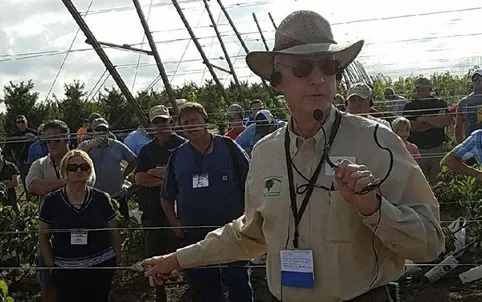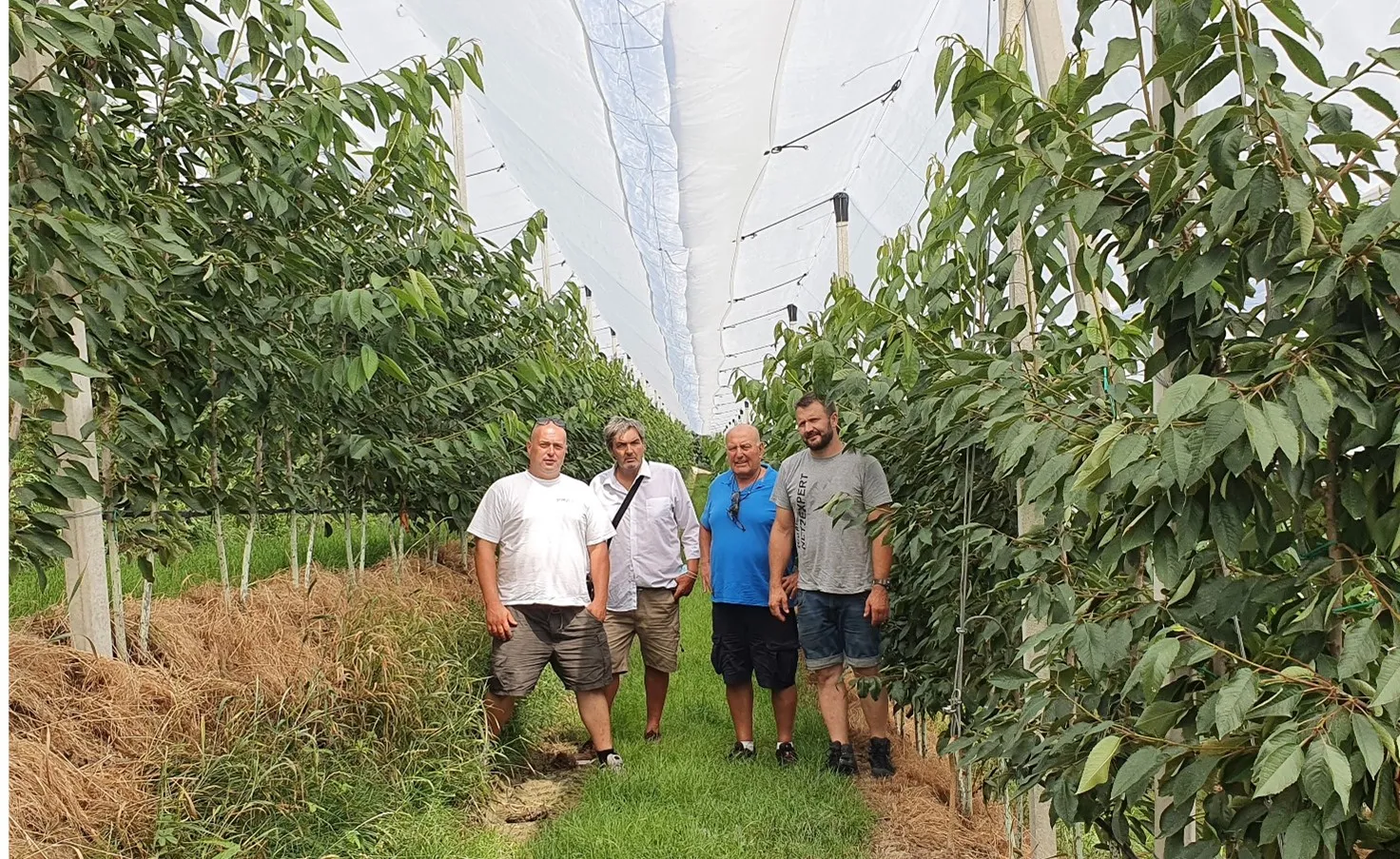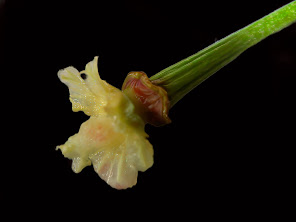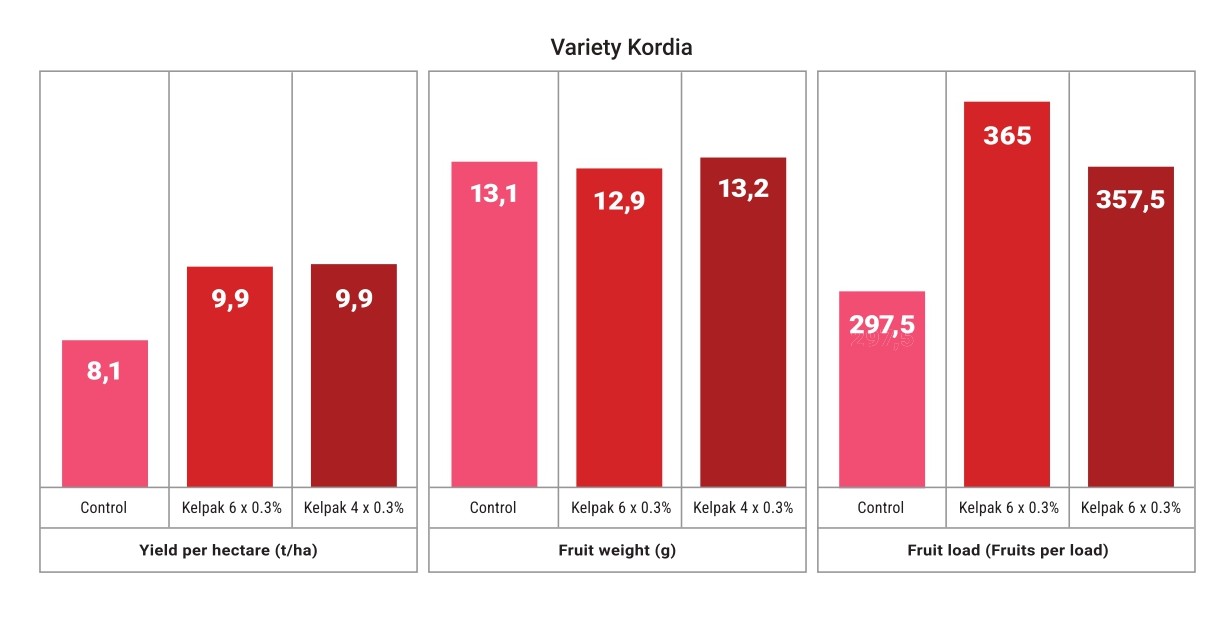
Greg Lang, retired professor of horticulture at Michigan State University, speaks from experience—20 years—when it comes to orchard coverings and covering systems. His pride and joy, multi-leader sweet cherries, are no strangers to added protection. Speaking on behalf of the Northeast Tree Fruit IPM Working Group, Lang offered several insights on protected cultivation of cherries and other stone fruits.
Types of Orchard Coverings
“Canopy structures (made of poles, wires, and tarps) tend to be the least expensive,” says Lang. “They can be mobile or fixed and have different types of ventilation.”
 Image 1: Example of a fixed canopy structure in South Tyrol (Italy).
Image 1: Example of a fixed canopy structure in South Tyrol (Italy).
"Some considerations include how much heat is trapped under those covers in a warm climate. This can be a disadvantage. In a cold climate, it can be an advantage if heat is trapped," says Lang. "If you're trying to advance bloom in spring, you want to trap heat. If you're trying to mature the fruit in a less stressful environment, you don't want to trap heat. So, there are always pros and cons depending on what the primary criteria for having the coverings are."
 Image 2: Covering of a young cherry orchard with a high tunnel structure in Michigan (USA).
Image 2: Covering of a young cherry orchard with a high tunnel structure in Michigan (USA).
Among high tunnels, the most common structure is the single-layer, multi-bay, three-season plastic tunnel compared to the single-bay, double-layer, standalone, four-season plastic tunnel often used for year-round vegetable production. Multi-bay high tunnels are generally less expensive per covered area than single-bay ones. Tri-season tunnels are left uncovered in winter, as the structures are not designed to withstand snow loads.
"If it's a single layer of plastic, as is typically the case in orchards, the heat retention is appreciable but not necessarily significant, apart from one or two degrees when it comes to spring frosts," Lang says.
Automated greenhouse-like structures can open and close based on inputs such as weather station sensors. While offering the most manipulation options, they are the most expensive. "They're easier to use, but you pay the upfront installation costs," Lang states.
Potential Benefits of Coverings
Cherry growers almost always aim to exclude rain to prevent cracking. Additional benefits of coverings for stone fruits include altered ripening times, frost protection, reduced disease, decreased wind-related bruising, bird protection, and the ability to harvest and prune in any weather condition.
"These are all the different factors to consider in determining whether a covering system will be economically sustainable," Lang says. Typically, when growers protect their stone fruit orchards from rain, they end up protecting those crops from most bacterial diseases, Lang notes. "We can virtually eliminate all the bacterial diseases we've learned to recognize as important in various stone fruits," he states.
 Image 3: Severe bacterial canker attack on an uncovered young cherry orchard in a high-altitude area (Modena, Italy).
Image 3: Severe bacterial canker attack on an uncovered young cherry orchard in a high-altitude area (Modena, Italy).
The cherry leaf spot fungus (Apiognomonia erythrostoma and other fungal species) can be essentially eliminated by preventing rain from splashing onto the leaves, Lang says. However, brown rot (Monilinia spp.) occurs at approximately the same incidence as without any covering, Lang adds. "We can reduce or eliminate some fungal diseases, but not all. We've found that we need to continue spraying fungicides for brown rot, regardless of whether we're under a covering or not," he explains.
At the other end of the spectrum, powdery mildew (Podosphaera clandestina Lév.) tends to increase in the dry environment of a rain exclusion system, according to Lang. "It's a typical disease in the West, in places like arid Washington. It's not as common in the East, but when you put up a cover, it can become quite prevalent," he states.
Images: Growing Produce; Sl Fruit Service
Thomas Skernivitz
Growing Produce
Cherry Times - All rights reserved
















